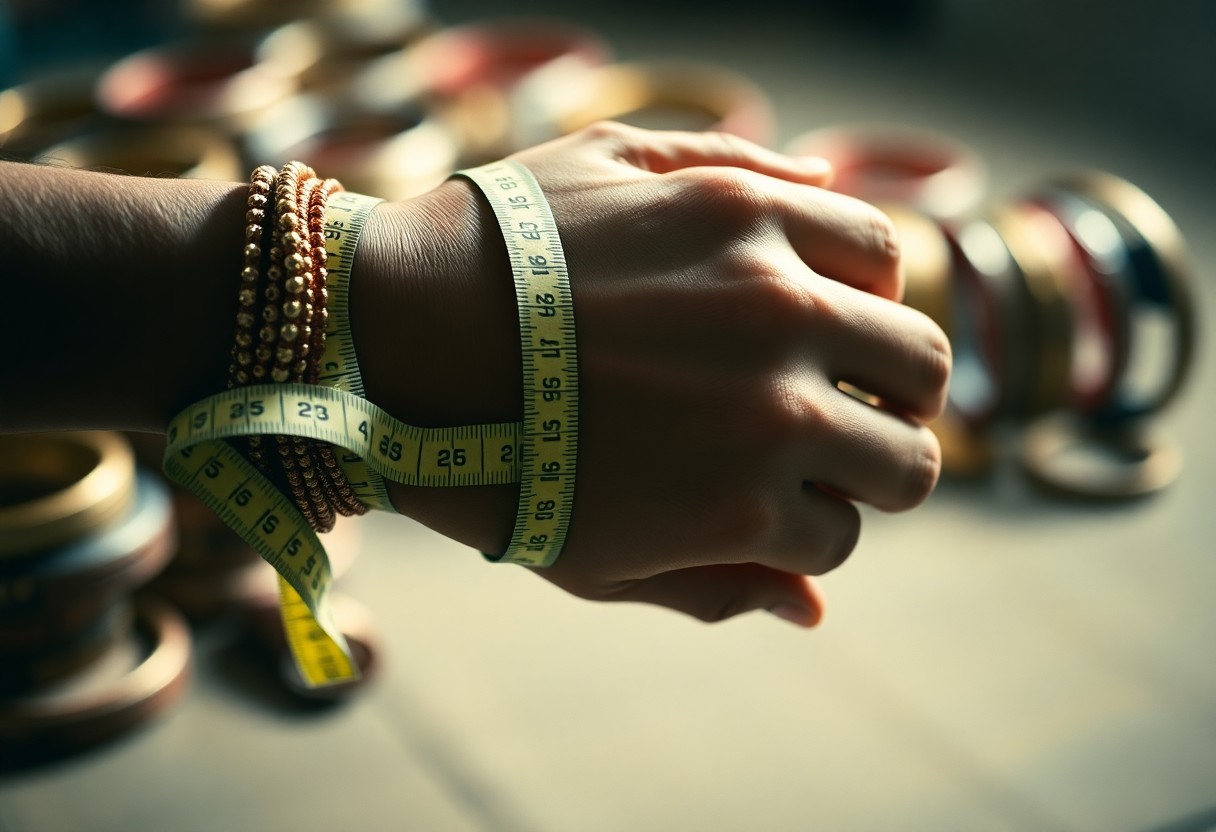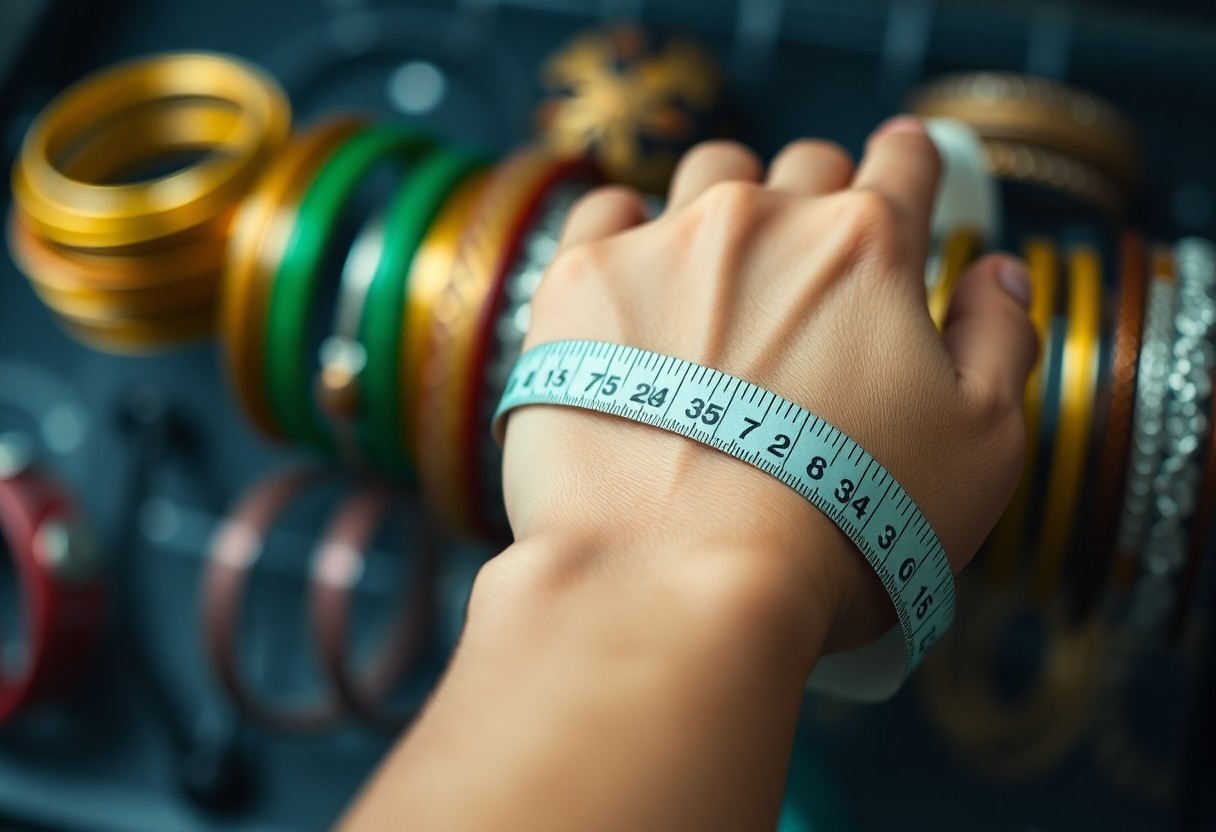Just understanding how to measure your bangle size can enhance your jewelry shopping experience and ensure a perfect fit. Accurate measurement is imperative, as a bangle that’s too tight can cause discomfort, while one that’s too loose may slip off. To find the correct size, you’ll need a tape measure or a piece of string along with a ruler. With these simple steps, you can confidently select the right bangle that not only looks beautiful but also feels comfortable on your wrist.
Table of Contents
Key Takeaways:
- Measurement Technique: Use a flexible measuring tape or a strip of paper to measure the circumference of your wrist just above the wrist bone.
- Size Conversion: After measuring the circumference, convert the measurement to bangle size using a size chart that correlates circumference to standard bangle sizes.
- Fit Consideration: Consider how you want the bangle to fit, opting for a size larger if you prefer a looser fit or a size smaller for a snug fit.

Understanding Bangle Sizes
The size of a bangle is important for ensuring a perfect fit that not only looks good but also feels comfortable on your wrist. Bangles are typically sized based on their diameter and circumference, and understanding these measurements will help you choose the right size for your wrist. Knowing your bangle size can prevent situations where the bangle is too tight, restricts movement, or is too loose and risks falling off.
Standard Sizing Charts
For your convenience, many jewelers offer standard sizing charts that correlate bangle sizes with wrist measurements. These charts typically show sizes in inches and centimeters, helping you easily convert your wrist size into a corresponding bangle size. Using these charts can save you time and effort, ensuring that you select the right size without trial and error.
Importance of Accurate Measurement
Assuming you’re going to wear your bangles frequently, it’s important to achieve the best fit for your comfort and style. A well-sized bangle not only enhances your look but also ensures it stays in place throughout daily activities.
It is vital to take your measurements carefully, as a poorly fitting bangle can lead to discomfort and even accidental damage to the piece itself. A bangle that’s too tight can cause blood circulation issues or discomfort, while one that’s too loose may slip off and become lost. Therefore, ensuring precise measurements is key to enjoying your jewelry without any worries. Consider using a flexible measuring tape or a piece of string to get the most accurate reading of your wrist size before making a purchase.
How to Measure Your Bangle Size
Some individuals find it challenging to determine their bangle size accurately. Using the right method can help ensure that your chosen bangle fits comfortably without being too tight or loose. Whether you prefer a straightforward approach or something a bit more creative, these tips will guide you through measuring your bangle size effectively.
Using a Measuring Tape
An easy way to measure your bangle size is by using a flexible measuring tape. Simply wrap the tape around the widest part of your hand — typically around your knuckles — and note the measurement. This will give you the circumference of your hand, which can help you choose a bangle that fits comfortably.
Alternative Measurement Methods
Even if you don’t have a measuring tape on hand, there are other effective ways to determine your bangle size. You can use a piece of string or ribbon, wrapping it around your hand, and marking the point where it overlaps. You can then measure this length against a ruler to determine the circumference. Another option is to use an existing bangle that fits well; simply measure its internal diameter, which can also help you find the right size.
The internal diameter method involves measuring the distance across the inside of the bangle rather than its circumference. To do this, you can use a ruler to measure straight across the bangle’s inner part. This can be particularly useful when shopping for bangles online, as it gives you a clear reference point. Make sure to choose a bangle size that is slightly larger than your hand measurement for a comfortable fit, especially if you have wider hands. This way, you can ensure that your bangle is both stylish and easy to wear.
Tips for Choosing the Right Bangle
Once again, when selecting the perfect bangle, keep the following tips in mind to ensure a great fit and style:
- Choose the appropriate size for comfort
- Consider different materials for durability
- Match the design to your personal style
- Think about the occasion when wearing it
Any choice you make will ultimately enhance your overall look.
Consider Your Hand Shape
Bangle size isn’t only about the circumference of your wrist; it also depends on your hand shape. Some people naturally have wider palms or longer fingers that require a more customized fit. If your hands are slender, a tighter bangle may work well, while broader hands might necessitate slightly larger bangles for comfort without compromising on style.
Factor in Personal Style Preferences
If you’re drawn to unique designs or classic styles, your personal preferences will greatly influence your bangle selection. Consider how a bangle complements your wardrobe and personal aesthetic, whether that means opting for bright colors, intricate patterns, or simple elegance.
With a clear understanding of your style preferences, you can confidently choose bangles that reflect your individuality. Balance factors such as fashion trends and your wardrobe staples to find pieces that seamlessly integrate into your collection. Avoid impulsive decisions; thoughtful selections ensure that your bangles not only look fabulous but also resonate with your unique taste and lifestyle.
Factors Influencing Bangle Fit
Keep in mind that various elements can affect your bangle fit, including:
- Hand size
- Wrist circumference
- Bangle style
- Material flexibility
Thou must consider these factors to ensure your bangle feels comfortable and looks great.
Thickness and Design of the Bangle
Any bangle’s thickness and design can significantly impact its fit. Thicker bangles may require a slightly larger size, while intricate designs with embellishments can restrict movement. Choosing a style you love that also fits well is paramount to ensuring comfort throughout the day.
Seasonal Changes in Hand Size
Changes in your body’s temperature and hydration levels can cause temporary fluctuations in hand size. During warmer months, your hands may swell due to heat, while colder days can lead to constriction. Being mindful of your body’s seasonal responses is imperative for selecting a bangle that remains comfortable year-round.
Influencing factors such as temperature, hydration, and even diet can lead to notable variations in your hand size. This means that a bangle that fits perfectly in the winter could feel too tight in the summer due to swelling. Awareness of these fluctuations will aid you in picking the right size, allowing you to enjoy your jewelry comfortably across all seasons.

Common Mistakes to Avoid
Despite your best intentions, it’s easy to make simple errors when measuring for the perfect bangle size. Common pitfalls include using inappropriate measuring techniques or overlooking necessary size variations. To ensure you select a bangle that fits well and is comfortable, take your time and avoid rushing through the measurement process.
Misjudging Size Variations
Assuming that all bangles are made with the same sizing guidelines can lead to discomfort and a poor fit. Sizes can vary significantly between different styles and brands, so always check the specifications from the manufacturer to find a size that corresponds with your measurements.
Ignoring Comfort
Some may prioritize aesthetics over comfort, leading to a poor wearing experience. Selecting a bangle that feels snug but not too tight is crucial for enjoyment. An uncomfortable bangle can restrict your movement and irritate your skin, which is why you should aim for a balance between style and practicality.
Variations in wrist size and personal preference can greatly affect how a bangle feels. Always consider the width and material of the bangle, as these factors impact flexibility and overall comfort. A bangle that is too tight can cause discomfort and irritation, while one that is too loose may slip off unexpectedly. Ultimately, prioritizing comfort ensures that you enjoy wearing your bangle without concern for fit issues or distraction from your daily activities.
Conclusion
Presently, measuring your bangle size is a straightforward process that ensures you find the perfect fit. By using a flexible tape measure or a string, you can easily determine your wrist’s circumference, which will help you choose the right bangle size. For step-by-step guidance, you can check out this video on How to know your Bangle size correctly. This way, you’ll enhance your jewelry collection with pieces that complement your style and comfort.
FAQ
Q: How do I determine my bangle size accurately?
A: To find your bangle size, use a flexible measuring tape. Wrap the tape around the widest part of your hand, usually at the knuckles, without pulling it too tight. Make a note of the measurement in inches or centimeters. To ensure a comfortable fit, add about half an inch for a looser fit or subtract a quarter inch for a snugger fit. Alternatively, if you have a bangle that you already own, measure the inner diameter of that bangle and use that measurement for reference.
Q: Can I use a string to measure my bangle size?
A: Yes, you can use a piece of string or a thin strip of paper as a substitute for a measuring tape. Wrap the string around the widest part of your hand as you would with a measuring tape. Once you have the string wrapped around, mark the point where the string overlaps and then measure that segment against a ruler to get your size in inches or centimeters. Be sure to add the same allowances for a comfortable fit as mentioned earlier.
Q: What if I am between two bangle sizes?
A: If your measurement falls between two sizes, consider the material of the bangle and your personal comfort preference. For bangles made of rigid materials like metal, choose the larger size to allow for easy wear. For flexible materials like fabric or elastomer, you might prefer the smaller size. If you are unsure, trying on both sizes can help you decide which feels more comfortable on your wrist.